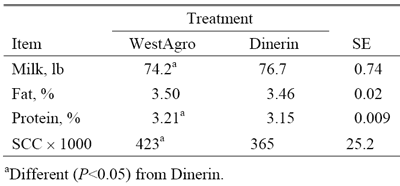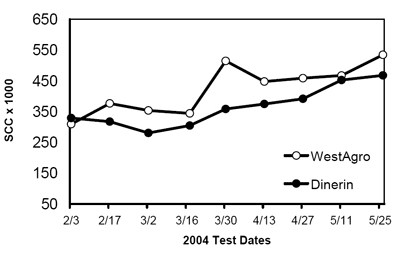Effect of a New Teat Dip on Somatic Cell Count, Incidence of Mastitis, and Milk Production in a Commercial Dairy
Published: July 24, 2008
By: J. E. Shirley, W. F. Miller, J. Rottinghaus, and E. C. Titgemeyer - Dairy Day publication, Kansas State University Agricultural Experiment Station and Cooperative Extension Service
Introduction
A new teat dip, Dinerin, developed by KO Manufacturing, Inc. (Springfield, MO) was evaluated in the Kansas State University dairy in 2003 against Westfalia/Surge DERMAKOTE and TEAT-KOTE 10-3. Although cows treated with Dinerin (0.50% iodine) had fewer cases of mastitis and numerically lower cell counts, a larger study was required to determine statistical relevance. Management and facilities may influence the general effectiveness of a teat dip; thus, the purpose of this study was to evaluate Dinerin teat dip in a commercial dairy located in Indiana. Further, the number of cows used was increased in an effort to evaluate milk response and to provide statistical relevance to the data.
Procedures
Holstein cows (n = 530) located in a commercial dairy herd near Birdseye, Indiana, were used to evaluate a new teat dip. Cows were housed and managed under normal procedures used by the dairy manager. Cows were housed in pens containing 110 to 140 cows per pen. Eight pens were used to accommodate the normal cow-movement procedures used at the dairy. Four pens of cows were treated and 4 pens of cows were controls. Pretreatment milk yield, milk components, and somatic cell count (SCC) were determined and used in covariant analysis. Treatments were balanced for parity, SCC, milk yield, and previous cases of clinical mastitis. Controls cows (n = 232) were treated under the current farm protocol (WestAgro Iodozyne pre-dip and WestAgro Blockade post-dip), and treated cows (n = 299) were pre- and post-dipped with Dinerin. The study was initiated February 17, 2004, and concluded June 25, 2004.
Normal management routine on the farm involved movement of cows among pens, depending on their reproductive status. Treatments were allotted to pens of cows so that cows within a treatment could be moved to another pen within that treatment to accommodate the normal reproductive program. Once cows were assigned to treatment, they remained on that treatment for the duration of the study or until they were dried-off or left the herd. Duration of the study was 90 days.
Data were collected from all cows initially assigned to treatment and from all cows that entered the treatment pens thereafter. Data collected from cows entering the pens after the study was initiated were not used in the analysis unless the cows completed at least 90 days on test. Cows that were dried off or left the herd before 90 days on treatment were not used in the final analysis. Individual cow milk samples were collected every 2 weeks and shipped to the DHI laboratory in Columbia, Missouri, for determination of fat, protein, urea nitrogen, and SCC. Milk weights were recorded each milk sampling date. Milk yields calculated by DHI were used in the analysis. All cases of clinical mastitis were recorded.
Results and Discussion
Data for milk yield, milk composition, and somatic cell count are shown in Table 1. Cows treated with the Dinerin teat dip (0.50% Iodine) produced (P<0.05) more milk than did cows treated with the WestAgro product (76.7 vs 74.2 lb daily). Milk fat percentage was similar, but milk protein percentage was greater in milk from cows treated with WestAgro teat dip. No differences were observed in the pounds of milk fat or protein produced daily. The numerical difference in milk fat percentage and the significant difference in milk protein percentage were attributed to a dilution effect because the pounds of milk fat and protein produced daily were similar. Dinerin teat dip reduced (P<0.05) somatic cell count, compared with the WestAgro teat dip (365,000 vs. 423,000 counts per mL of milk). A graphical depiction (Figure 1) of somatic cell counts indicates that cows treated with Dinerin teat dip had lower counts during the entire study. The improvement in daily milk yield was attributed to less sub-clinical mastitis, as evidenced by fewer somatic cells in milk from the cows treated with Dinerin teat dip. No difference was observed in the incidence of clinical mastitis.
Conclusion
Dinerin teat dip containing 0.50% Iodine (KO Manufacturing, Inc., Springfield, MO) reduced somatic cells and improved milk yield when compared with another commercial barrier teat dip when applied during late winter and spring in Indiana.
Table 1. Effect of Teat Dips on Production Traits in a Commercial Dairy


Figure 1.Effect of Teat Dip on Somatic Cell Count (SCC).
Related topics:
Recommend
Comment
Share

Would you like to discuss another topic? Create a new post to engage with experts in the community.
Featured users in Dairy Cattle

José Manuel Oropeza Meza
MSD - Merck Animal Health
Gerente Nacional Cuentas Clave en MSD Salud Animal
United States
United States






